Physical Address
304 North Cardinal St.
Dorchester Center, MA 02124
Spasticity is a condition characterized by muscle hypertonia, caused by a hyperactive stretch reflex mechanism, usually linked to a central neurological insult. It is responsible for various limb deformities, causing variable functional impairments.
Its primary treatment is non-surgical, but in selected cases, surgery may be indicated. The goal is to improve function by rebalancing the existing deforming forces, namely spasticity, muscle and joint contracture, and paralysis. Multiple procedures are used to address each of them. In some cases, however, the goal will be limited to improving hygiene and comfort, reducing pain, or correcting a severe deformity.
The clinical picture varies greatly among patients, related to the extent and severity of spasticity. A thorough clinical examination, standardized charts, and repeated video recordings are key elements to the decision-making and a successful outcome.
Experience is required, and surgical treatment is best handled with a specialized team involving all health professionals involved in the patient’s care.
![]() Access video content for this chapter online at Elsevier eBooks+
Access video content for this chapter online at Elsevier eBooks+
Spasticity is a condition characterized by muscle hypertonia. It is linked to a central neurological impairment involving the pyramidal tract. It is caused by a hyperactive stretch reflex mechanism, responsible for various limb deformities, with variable functional impairment related to the extent and the severity of spasticity.
It may occur in several circumstances: in children, cerebral palsy, in adults, it is usually related to a vascular or traumatic brain damage, less frequently to spinal cord injury.
Spasticity is rarely an isolated feature. The clinical picture generally includes other neurological and orthopedic impairments which need to be carefully assessed as well.
The initial treatment for spasticity is non-surgical, including a wide range of physical and occupational therapy techniques. Pharmacologic agents may be used as an adjunct. In selected cases, surgery may be indicated following proper conservative treatment.
The spastic hand represents one of the most challenging problems in upper limb reconstructive surgery. Whenever possible, surgery aims at improving function. The goal is to correct the deformities by rebalancing existing forces. In some cases, however, it will be limited to improving hygiene and comfort, reducing pain, or correcting a severe deformity. Multiple surgical techniques are used to address different components of the upper extremity deformity, such as spasticity, muscle contracture, joint contracture, and paralysis; this goal-specific surgical plan underscores the need for a preliminary thorough physical examination.
Cerebral palsy has been defined as a group of permanent disorders of the development of movement and posture, causing activity limitation, that are attributed to non-progressive disturbances that occurred in the developing fetal or infant brain. The motor disorders of cerebral palsy are often accompanied by disturbances of sensation, perception, cognition, communication, and behavior, by epilepsy, and by secondary musculoskeletal problems.
Perinatal asphyxia is responsible for only 5–10% cases of cerebral palsy. Other causes include meningo-encephalitis, traumatic brain injury, and cerebrovascular accidents related to congenital vascular malformations. Hemiplegia is the most common manifestation of cerebral palsy. It develops progressively during growth, but once established, follows a non-progressive course, which makes it amenable to surgical treatment in selected cases.
CVA usually affects senior patients. The clinical picture follows an initial flaccid phase. Spasticity occurs after a few weeks and establishes progressively in the recovering muscles, frequently leading to muscle contractures. Sensation is often severely impaired in the hand. It may fail to improve despite dramatic motor improvement, leading to neglect and impairing functional recovery. These features may not allow functional surgery. However, procedures aiming at reducing spastic contractures, and improving hygiene and nursing, are helpful in a number of cases.
The initial trauma may involve various portions of the brain and cerebral trunk and the clinical features will vary accordingly. Motor impairment depends upon the extent of brain damage. It may recover fast in some patients, or remain severe in others. Muscle contractures may develop rapidly, and must be corrected surgically if needed. Other neurologic disorders are often predominant, e.g., cerebellar syndrome, cognitive or frontal impairment, many of which prevent surgical attempts at improving function to the upper limb.
Spasticity in tetraplegic patients usually occurs in the lower limbs. According to Zancolli, it affects the upper limbs in only 15% of patients, mainly at the wrist and finger level in patients with incomplete tetraplegia. Spasticity, when moderate, does not interfere with surgical rehabilitation of the tetraplegic upper limb. It can actually be useful to the patient, who by triggering the stretch reflex, can initiate a pinch or a grasp. When spasticity is significant, it causes deformities which must be corrected prior to reconstructive surgery. When it is predominant, tendon transfers may not be possible.
The clinical picture may vary greatly from one individual patient to the other, depending on the location and extent of the central nervous system insult. Regardless of the cause of the brain insult, the clinical examination should be conducted in the same manner. It is a critical part of the assessment and the principal factor of the surgical decision-making.
It is aimed at detecting and assessing all the factors responsible for the deformity, each of them requiring a specific treatment. Its goal is fourfold:
Evaluate spasticity.
Evaluate possible muscle contracture and joint deformity
Evaluate motor and sensory impairment in the upper limb
Evaluate existing function, and functional needs of the upper limb.
It is completed by a general examination in order to seek associated neurological disorders, and potential contraindications to surgery. The data are recorded on standardized charts, which will allow intra- and inter-comparisons of the outcome.
This examination is best performed as a team, including all the specialists involved in the patient’s care (physical therapist, occupational therapist, physiatrist, neurologist, and surgeon). It should ideally be done in a warm, quiet, and friendly environment to limit spasticity.
Clinical manifestations within the same patient may vary greatly with a number of factors, including the patient’s emotional state and fatigue level, ambient temperature and the time of day. Therefore, it is unwise to decide on surgery after a single session, and assessment should be repeated before any decision-making. Standardized assessment charts and video recording are performed before and after each step of treatment.
Inspecting the limb at rest prior to examination provides much information on spasticity. It usually predominates in the adductor, flexor, and pronator muscles, leading to a typical resting posture in shoulder adduction and internal rotation, elbow flexion, forearm pronation, and wrist flexion ( Figs. 29.1 & 29.2 ). But on occasions some patients display very different positions, such as shoulder abduction and external rotation (most often in quadriparetic children), elbow or wrist hyperextension.
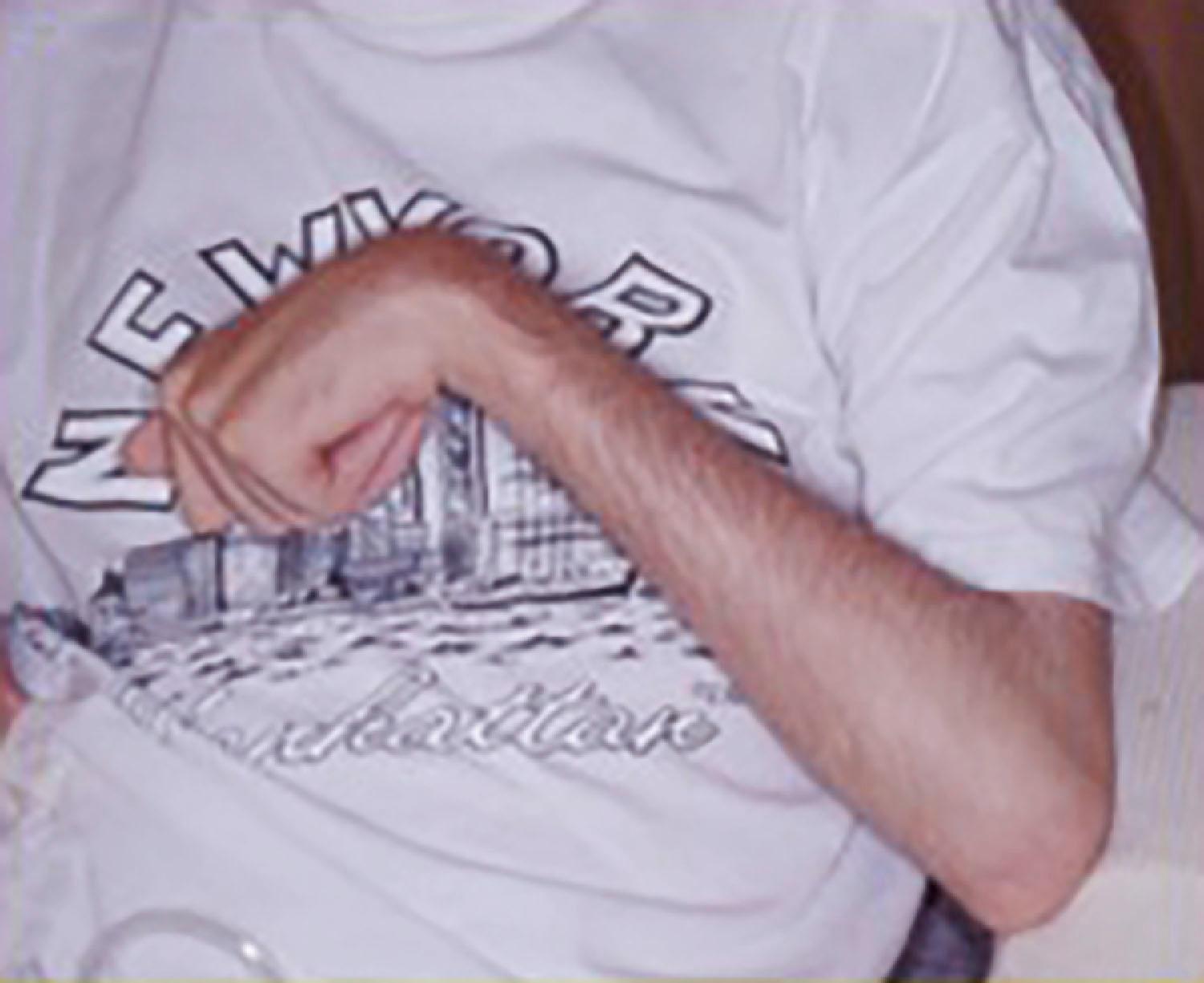
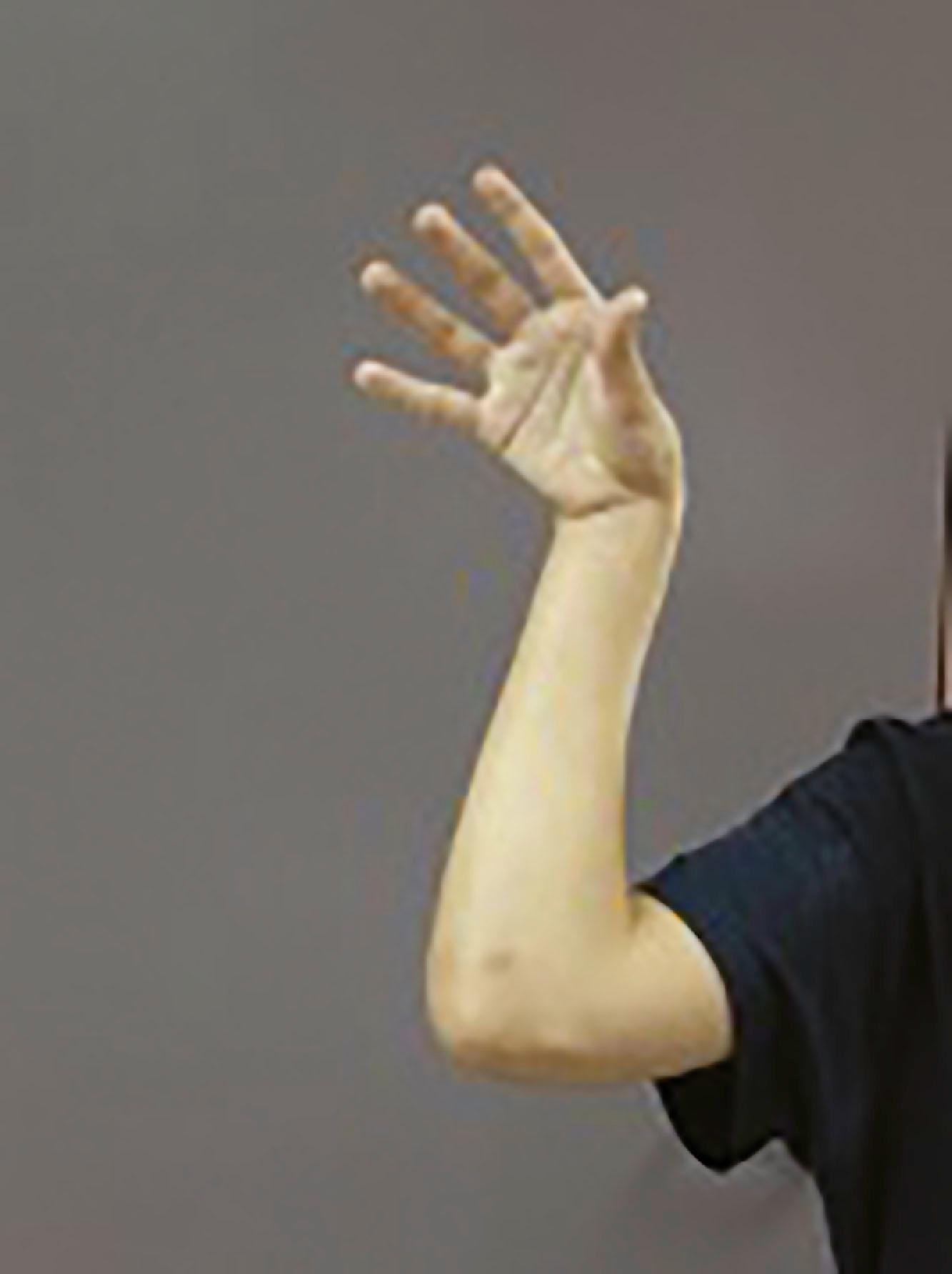
The fingers may assume varied positions. Most frequently they are clenched into a tight fist. Less typically they assume a swan-neck deformity, an “intrinsic plus” deformity with flexion of the metacarpophalangeal (MCP) joints and hyperextension of the interphalangeal (IP) joints ( Fig. 29.3 ), or the opposite “intrinsic minus” deformity, with the MP joints hyperextended and the proximal interphalangeal (PIP) joints flexed. A boutonnière deformity is less common.
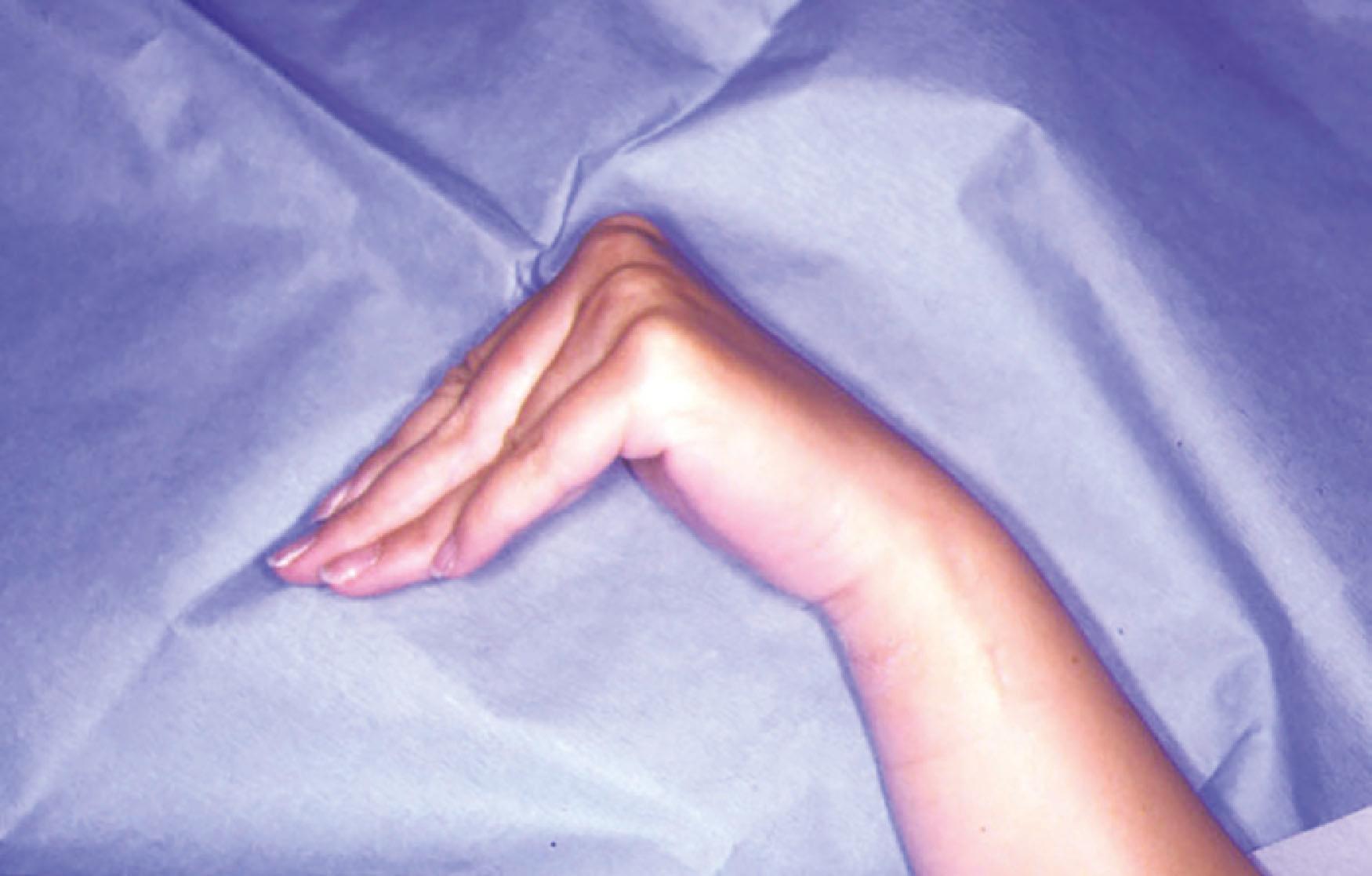
The thumb can assume either an adducted or an adducted and flexed posture, often referred to as “thumb-in-palm”, where the thumb is embedded in the palm with full flexion of both MCP and IP joints, preventing any kind of use of the hand ( Fig. 29.4 ).
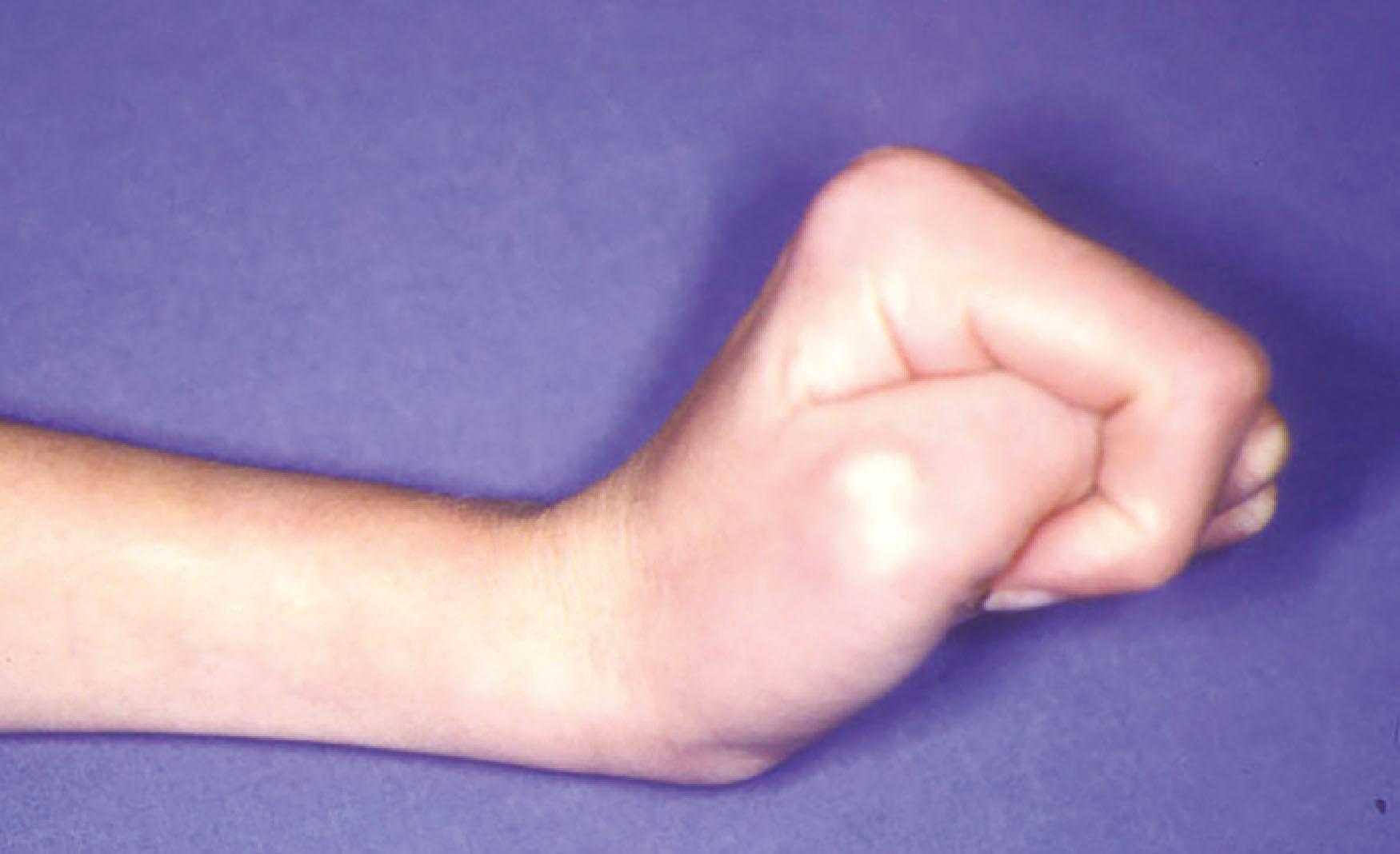
Spasticity is a muscle hypertony, characterized by five classical clinical features:
It is selective, predominantly involving the flexor, adductor, and pronator muscles and responsible for the characteristic “flexion–pronation” deformity of the upper limb.
It is elastic. Attempts at reducing the deformity meet with a resistance, which increases with the strength applied. If the opposing force is maintained long enough, the deformity usually yields, but the limb returns to its initial position as soon as the attempt is stopped.
It is present at rest, and exaggerated with voluntary movement, emotion, fatigue, and pain.
Osteotendinous reflexes are exaggerated, brisk, diffuse and polykinetic.
There may be associated synkineses, described as “the phenomenon whereby paralysed muscles incapable of a certain voluntary movement, execute this movement in a voluntary fashion by accompanying intact muscles”.
The shoulder is usually relatively spared. At the elbow level, spasticity involves predominantly all three flexors, but the triceps can also be spastic.
Spasticity of the wrist flexors and pronators leads to the characteristic hyperflexed and hyperpronated deformity. Finger spasticity is difficult to assess if the wrist is hyperflexed. The finger flexors are frequently involved, and the interossei muscles to a various amount. All thenar muscles may be affected.
Quantitative evaluation of spasticity is challenging. The classical Ashworth and modified Ashworth scales have been recognized as too subjective and should be combined with the more accurate Tardieu scale.
Muscle contracture is a result of longstanding, unopposed spasticity of muscles. Unlike spasticity, it is permanent and cannot be overcome, although shortening the involved articular segment can alleviate it. For example, posturing the wrist in flexion relieves contracture of the finger flexors. This is assessed by Volkmann’s angle, which is the degree of wrist flexion required to obtain full passive finger extension. Contracture of the intrinsic muscles of the fingers is assessed by the Finochietto test ( Fig. 29.5A,B ).
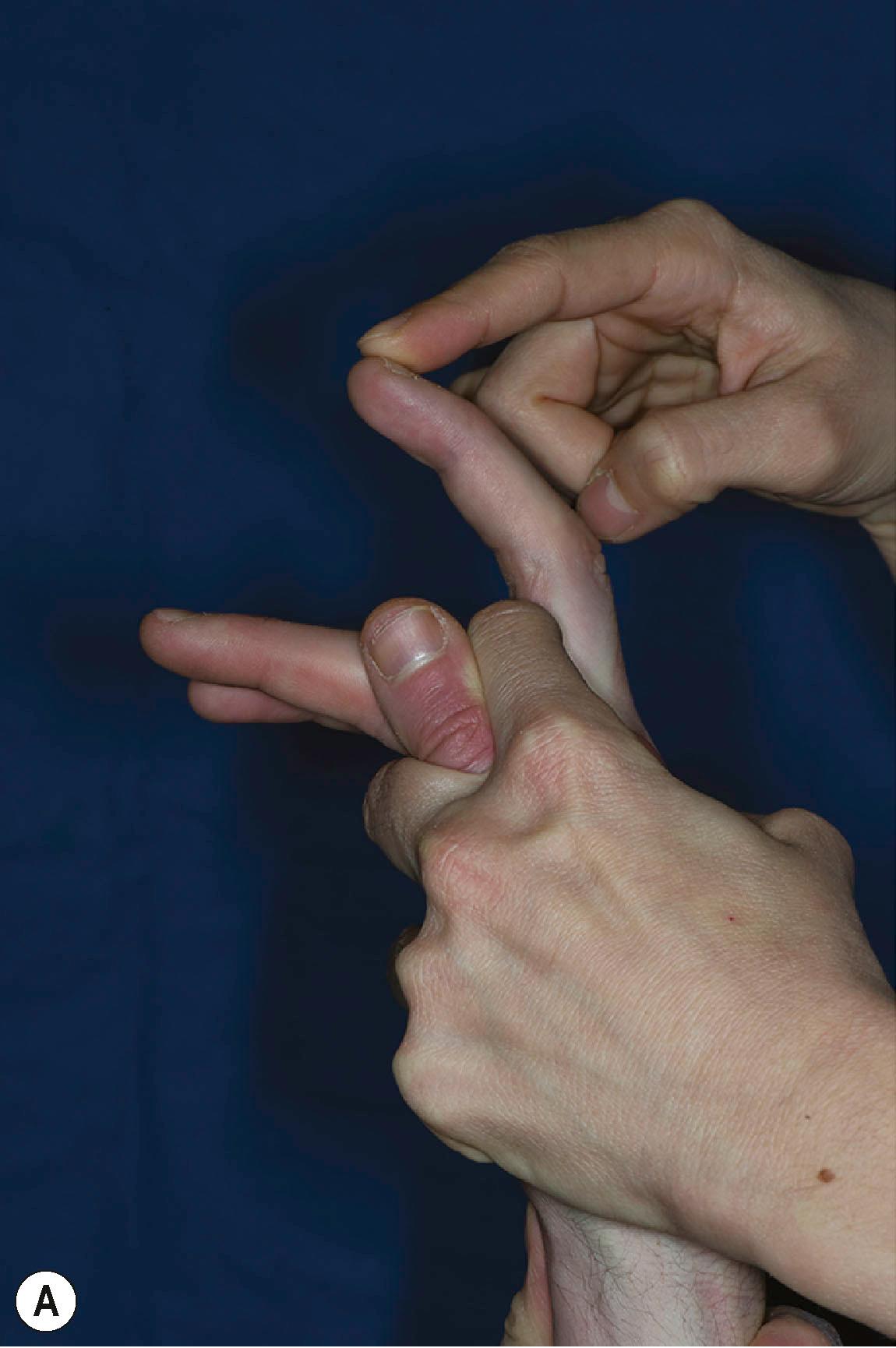
Clinical distinction between contracture and spasticity may be difficult to establish. In such cases nerve blocks, or botulinum toxin are useful.
Passive motion of the involved joints may be difficult to assess because of associated muscle contractures. Sometimes it is not until muscle contractures have been surgically released that the actual range of passive motion can be evaluated.
In spastic children, increased passive extension of some joints may result in joint instability, mostly at the thumb MCP joint, and at the finger PIP joints (leading to a swan-neck deformity) ( Fig. 29.6 ).
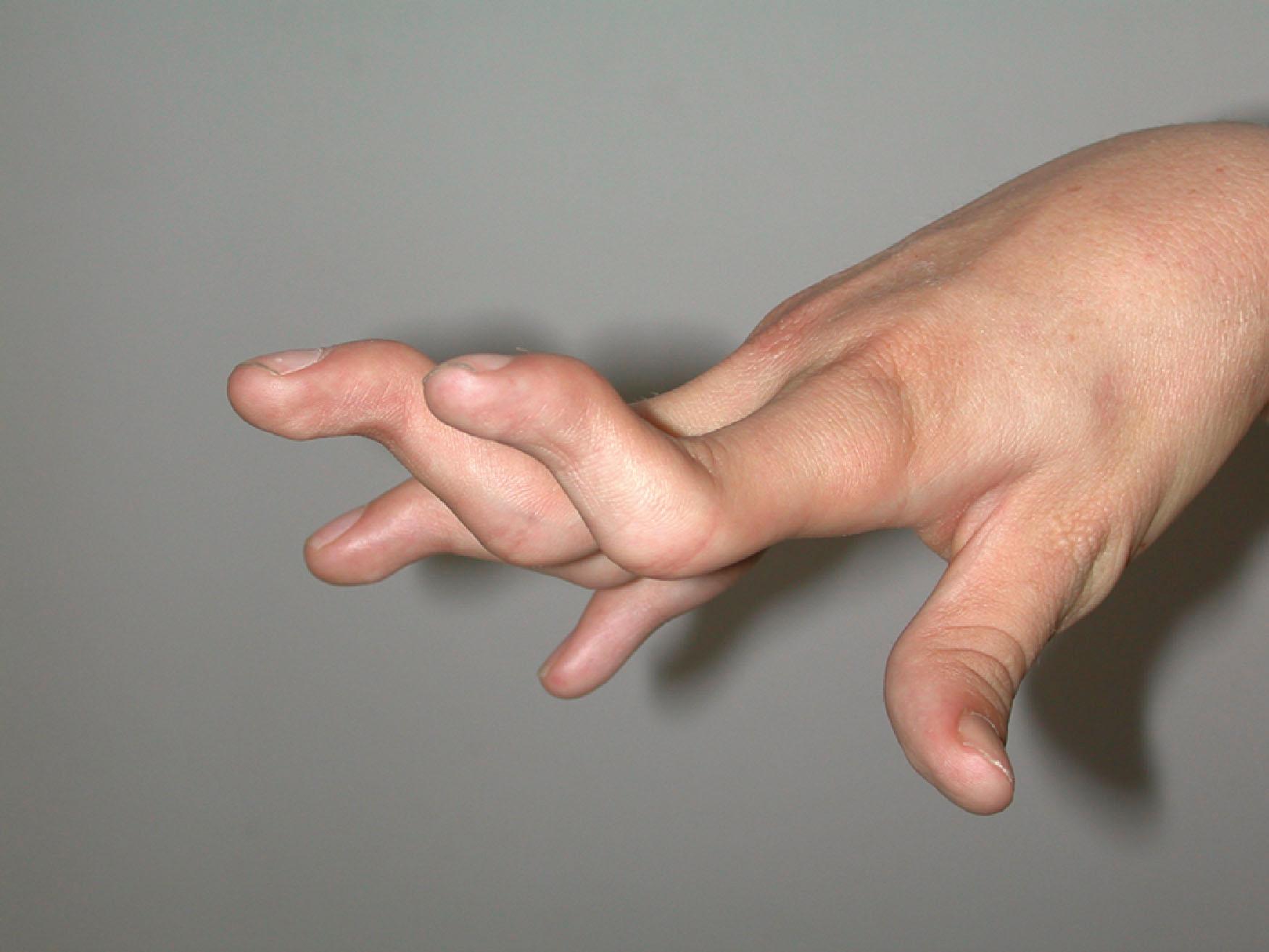
Motor examination of the spastic upper limb is difficult, especially when the deformities are severe. The flexor, adductor, and pronator muscles, mostly spastic, usually retain some voluntary control. Assessing their strength with the classical Medical Research Council (MRC) grading scale may be challenging when severe deformities are present.
The palsy usually predominates distally, and involves the antagonist muscles (extensor and supinator muscles). Rather than actually paralysed, these muscles may be present, but made ineffective by the spastic agonists. Botulinum toxin of the spastic agonists can be helpful: by decreasing their tone, it allows a proper evaluation of the “paralysed” muscles, which may end up demonstrating a satisfactory voluntary control.
Spontaneous involuntary movements are recorded: dystonia, characterized by involuntary intermittent muscle contractions causing repetitive movements and/or abnormal postures, is common in cerebral palsy patients. When predominant, it is a contraindication to surgery.
Some attempts at classification of the spastic upper limb have been made. Aside from Tonkin’s specific thumb classification, we have not found any of them very helpful because of the infinite range of clinical pictures, many of which do not fit into any of the described categories.
Become a Clinical Tree membership for Full access and enjoy Unlimited articles
If you are a member. Log in here